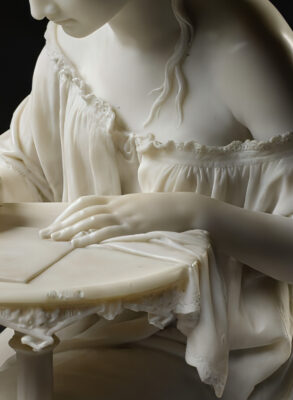
A Visionary Sculptor of the 19th Century: Giovanni Spertini
Giovanni Spertini (1821–1895) was a renowned Italian sculptor celebrated for his exceptional skill in working with marble. His artistry stood out for its nuanced portrayal of human emotions, attention to detail, and the graceful rendering of figures. As one of the notable sculptors of the 19th century, Spertini was at the forefront of an artistic movement that embraced realism and sentimentality, making him a prominent figure in the Italian artistic scene.
Throughout his career, Spertini’s works were a testament to his technical prowess and ability to capture the complexity of human nature. His sculptures were not merely representations of the human form but were infused with a deep sense of life, feeling, and elegance. His marble pieces exemplify the delicate balance between form and emotion, making them timeless representations of 19th-century ideals.
Influence of Romanticism
Giovanni Spertini’s work was heavily influenced by the Romanticism movement that swept through Europe during the early to mid-19th century. Romanticism focused on individualism, the beauty of nature, and the expression of personal emotions, often in contrast to the rigid classical traditions that preceded it. This movement emphasized the subjective experiences of the artist and the viewer, highlighting themes of love, introspection, and dramatic emotional expression.
Spertini’s “Girl Writing”, created in 1874, perfectly embodies the essence of Romanticism. The sculpture depicts a young woman deep in the act of writing, seemingly lost in thought, her posture reflecting both concentration and introspection. This portrayal of a quiet, intimate moment underscores the Romantic ideal of personal expression and the exploration of the inner life of individuals. The figure’s elegance, combined with the emotional depth of her task, captures the Romantic spirit in a way that resonates with modern viewers.
The style of the work reflects the Romantic idealization of youth, intellectual pursuit, and the contemplative solitude that was often romanticized during the period. The delicate balance between the woman’s physical form and the emotional depth of her engagement with writing makes the sculpture a quintessential example of the period’s focus on the beauty of human experience.
Legacy of Giovanni Spertini
Although Giovanni Spertini may not have achieved the widespread fame of some of his contemporaries, such as Antonio Canova or Jean-Baptiste Carpeaux, his work has had a lasting impact on the field of sculpture. Spertini’s ability to blend technical skill with emotional expression left a significant legacy in 19th-century art. His marble sculptures, including “Girl Writing”, continue to captivate art enthusiasts and scholars, showcasing the enduring appeal of Romanticism and classical influences.
Spertini’s contributions to sculpture remain relevant and influential, as his works offer a glimpse into the emotional and intellectual currents of the 19th century. The continued appreciation for his works attests to the timeless beauty and significance of his artistic vision. His legacy lives on through his ability to transcend the boundaries of his era, capturing the complex, emotional world of humanity in stone.
Moreover, Spertini’s influence is seen not only in his contemporaries but also in modern art, where the fusion of emotional expression and technical mastery remains a cornerstone of sculpture. His work, exemplified by “Girl Writing”, continues to inspire and challenge artists and art lovers alike, serving as a reminder of the depth of artistic possibilities within the medium of marble sculpture.
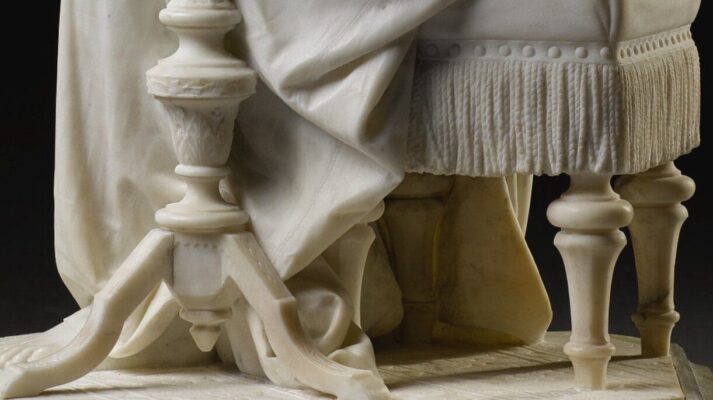
The Sculpture: “Girl Writing”
Artistic Composition: A Moment of Introspection
Giovanni Spertini’s “Girl Writing” is a striking representation of youthful serenity and intellectual engagement, captured in exquisite marble. The sculpture depicts a young girl seated in a quiet, contemplative pose, absorbed in the act of writing. Her body language is gentle, with her posture conveying a sense of stillness and focus. Every detail of the figure, from her delicate posture to the soft curve of her hands, is skillfully carved, reflecting a moment of introspection and deep thought.
The girl’s expression is serene, her gaze directed downward as she writes, conveying a sense of absorption in her task. Her facial features are subtle yet full of life, hinting at the emotional depth of her inner world. Through this pose, Spertini masterfully captures the balance between physical stillness and mental activity, highlighting the quiet power of introspection. The elegant drapery of her clothing further enhances the quiet elegance of the moment, with every fold and texture meticulously detailed to convey the softness of the fabric. Spertini’s ability to carve marble to mimic the fluidity and delicacy of fabric gives the sculpture a dynamic quality, making it feel as though the scene might come to life at any moment.
Symbolism of Writing: Intellectual Pursuits and Creativity
In the 19th century, writing was more than just a practical activity; it was a powerful symbol of intellect, creativity, and self-expression. During this period, education and the ability to write were closely associated with personal development and social status. Spertini’s “Girl Writing” not only portrays a young girl engaging in the act of writing, but it also serves as a tribute to the intellectual and creative pursuits of the era.
Writing in the sculpture can be interpreted as a symbol of the girl’s inner world, her intellectual capacity, and her ability to communicate her thoughts and ideas. The act of writing in art during this time was often used to represent the pursuit of knowledge, personal reflection, and the cultivation of the mind. The sculpture captures the importance of intellectual labor, which was increasingly valued during the 19th century, as well as the growing cultural emphasis on personal reflection and the expression of individual ideas. The girl’s solitary engagement with writing offers a quiet, powerful glimpse into the social and cultural atmosphere of the time, where education and introspection were deeply valued.
Moreover, writing as a motif often represents the connection between the individual and the broader cultural landscape. By choosing to depict writing in his sculpture, Spertini subtly comments on the significance of self-expression and the personal narratives that shape one’s identity. The girl’s act of writing is both a personal endeavor and a universal theme, resonating with audiences as a symbol of the ongoing human quest for knowledge and meaning.
Mastery in Marble: Technical Expertise and Lifelike Detail
One of the most striking features of Spertini’s “Girl Writing” is his unparalleled skill in marble carving. The sculptor’s technical expertise is evident in every aspect of the work, from the lifelike texture of the girl’s clothing to the intricate details of her writing tools. The marble has been expertly shaped to capture the softness of fabric, the fluidity of movement, and the delicate features of the girl’s face.
The marble texture is so finely worked that the clothing appears almost weightless, flowing with a natural grace. Each fold and crease in her dress is meticulously sculpted, showing Spertini’s deep understanding of how fabric behaves and folds around the human form. The girl’s hands are particularly impressive, as they are not only anatomically correct but also exude a sense of delicate precision, as if they are ready to move and write at any moment.
The writing tools held in the girl’s hands are rendered with equal care, reflecting the sculptor’s attention to every detail. The quill, in particular, appears almost real, as if it could be picked up and used. The combination of these fine details showcases Spertini’s ability to breathe life into the marble, turning a rigid, inanimate material into an expressive, fluid work of art. The softness of the girl’s facial features, with the slight curve of her lips and the gentle angle of her head, suggests a depth of emotion and introspection, achieved through the subtle manipulation of the marble.
This work stands as a testament to Spertini’s skill in transforming marble into a medium that transcends its hardness, evoking a sense of realism and warmth. The technical mastery displayed in “Girl Writing” reinforces the artist’s place among the great sculptors of the 19th century, blending art, emotion, and craftsmanship in a timeless piece.
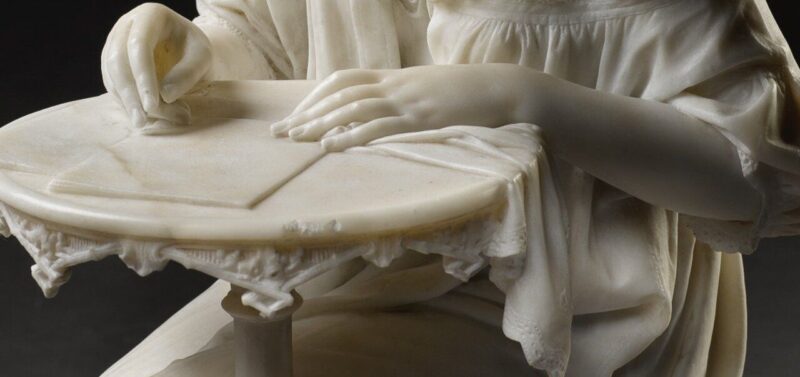
Giovanni Spertini’s “Girl Writing” (1874): A Masterpiece in Marble
Representation of Women in Art: Celebrating Female Intellect and Creativity
Giovanni Spertini’s “Girl Writing” presents a poignant and meaningful representation of women in 19th-century art, reflecting the changing roles of women in society. During this period, the 19th century saw a gradual shift in the way women were depicted in art, moving away from merely being portrayed as passive subjects to being seen as active participants in intellectual and creative pursuits. By choosing to depict a young girl engaged in the act of writing, Spertini not only emphasizes the intellectual capability of women but also celebrates their creative contributions to society.
The act of writing, often associated with intellect and education, serves as a powerful symbol of autonomy and empowerment in this sculpture. At a time when the roles of women were largely confined to the domestic sphere, the depiction of a young girl immersed in an intellectual task challenges traditional gender norms and offers a glimpse into the evolving societal attitudes toward female education. “Girl Writing” suggests a new wave of thinking, where women were increasingly encouraged to engage with the world of ideas, knowledge, and creativity.
This portrayal goes beyond mere representation; it also elevates the subject of the sculpture as an active thinker, capable of contributing to the intellectual and cultural landscape of her time. Spertini’s choice to depict a girl rather than an older woman highlights the potential for intellectual and creative growth from an early age, suggesting that women, too, could aspire to careers or roles traditionally reserved for men, such as writers, artists, and thinkers. In this way, Spertini’s work can be seen as a celebration of female intellect and a commentary on the importance of fostering creativity in women.
Reflection of 19th-Century Values: Romanticism and the Individual
“Girl Writing” is not only a depiction of a young woman but also an embodiment of the core values of the Romantic era, an artistic movement that emphasized individual expression, emotional depth, and the beauty of ordinary moments. The Romantic movement was in part a reaction against the industrialization and rationalism of the preceding centuries, focusing instead on the individual’s connection to nature, emotion, and personal experiences.
Spertini’s sculpture reflects these values by showcasing a solitary moment of introspection and intellectual engagement. The girl is depicted in a private, almost sacred space, where she is free to express herself without interruption. This solitary act of writing mirrors the Romantic ideal of individual thought and creative expression, suggesting that the act of writing is not only a form of communication but also an intimate, personal experience.
Furthermore, “Girl Writing” celebrates the beauty found in mundane, everyday activities, a hallmark of Romanticism. While writing is an intellectual activity, it is also a daily task that many engage in, and Spertini elevates this simple, repetitive act into a moment of artistic significance. Through this focus on the ordinary, the sculpture also explores the Romantic notion that even the most routine actions can carry deep emotional weight and personal meaning. In this sense, the piece invites viewers to reflect on the beauty of their own daily lives and the potential for creativity and introspection within the simplest of moments.
Timeless Appeal: Universal Themes of Curiosity and Creativity
While “Girl Writing” is firmly rooted in the context of 19th-century art and Romantic ideals, its themes continue to resonate with contemporary audiences. The universal appeal of the sculpture lies in its portrayal of intellectual curiosity and the pursuit of creativity—values that transcend time and remain as relevant today as they were in Spertini’s era.
The depiction of the girl, engrossed in writing, represents an enduring symbol of intellectual engagement and the quest for knowledge. Writing, in many ways, serves as a metaphor for the human desire to understand the world, express individual thoughts, and contribute to collective cultural heritage. Whether it is in the form of literature, art, or other creative outlets, the pursuit of creativity and intellectual growth continues to inspire people across cultures and generations.
Moreover, “Girl Writing” touches on a fundamental human experience—the need to express oneself. The act of writing, as portrayed in the sculpture, suggests an ongoing search for meaning, understanding, and self-expression. It speaks to the emotional power of creativity, which continues to play a vital role in the lives of many today. This timeless theme of creativity as a means of personal and intellectual growth invites viewers to contemplate their own creative journeys and the value of intellectual pursuits.
In today’s world, where the importance of education and self-expression remains a central focus, Spertini’s work stands as a reminder of the power of creative thought and the universal human quest for knowledge. The sculpture continues to captivate audiences not only for its technical mastery but also for the depth of its symbolic message, making it a timeless masterpiece that continues to speak to the hearts and minds of viewers worldwide.
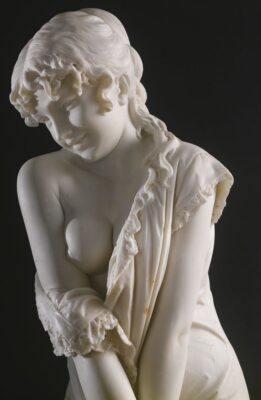
See more: The Sacred Well of Predio Canopoli: A Bronze Age Relic in Sardinia
Preservation and Legacy
Exhibition and Recognition: The Lasting Impact of Girl Writing
Since its creation in 1874, Giovanni Spertini’s Girl Writing has captured the admiration of art collectors, galleries, and museums around the world. Its exquisite craftsmanship and emotional depth have solidified its place as one of the defining works of 19th-century sculpture. The piece has been displayed in various prestigious art exhibitions, where its intricate details and evocative representation of intellectual engagement continue to evoke awe and wonder in audiences. In private collections, it serves as a treasured example of Spertini’s mastery in marble, representing both the artist’s skill and the cultural values of the era.
As one of Spertini’s most celebrated sculptures, Girl Writing has played a significant role in preserving the legacy of the artist and his contributions to the field of sculpture. Over the years, the piece has been studied by historians, art critics, and curators, all of whom have noted its technical brilliance and deep emotional resonance. The sculpture continues to be a centerpiece in exhibitions focused on 19th-century art, Romanticism, and the representation of women in art, making it an essential part of the dialogue surrounding classical sculpture and its impact on the cultural landscape.
Through these exhibitions and recognitions, Girl Writing has helped ensure that Giovanni Spertini’s legacy endures in the world of art, cementing his place among the great masters of 19th-century sculpture. It serves not only as a beautiful work of art but also as a symbol of the intellectual and artistic movements of the time, providing a bridge between past and present for contemporary art lovers.
Influence on Modern Art: Bridging the Classical and Contemporary
The influence of Girl Writing extends far beyond the 19th century, continuing to inspire modern artists and sculptors. In an era where contemporary art often explores new forms, mediums, and abstract concepts, the timeless beauty and craftsmanship of classical sculpture still hold significant relevance. Artists today draw inspiration from the precision, emotional depth, and naturalism found in Spertini’s work, incorporating elements of classical sculpture into their own pieces while exploring the themes of intellectual engagement, introspection, and the human experience.
The ability of Girl Writing to inspire modern artists is a testament to the enduring relevance of classical traditions in contemporary art. While the subject matter and techniques may have evolved, the core principles of classical art—such as the pursuit of emotional resonance and the careful attention to detail—remain at the heart of modern artistic endeavors. The depiction of a young girl engaged in the act of writing continues to resonate with artists and viewers alike, serving as a reminder of the power of individual thought, creativity, and self-expression.
Moreover, Spertini’s work influences not only traditional sculptors but also artists working in other media, from painters to digital creators. The focus on the human figure, the exploration of intellectual themes, and the emotional depth of the sculpture can be seen in the works of contemporary creators who seek to explore similar themes through different lenses. Girl Writing thus remains a bridge between classical art and modern expressions, showing that the themes and emotions captured by Spertini are still meaningful in today’s artistic dialogue.
A Symbol of Artistic Excellence: Bridging Historical Art and Modern Appreciation
Giovanni Spertini’s Girl Writing stands as a monumental example of 19th-century artistic excellence, not just for its technical skill but also for its deep emotional resonance and intellectual engagement. The sculpture represents the pinnacle of Romantic-era sculpture, demonstrating the movement’s commitment to portraying the individual, the human condition, and personal introspection through artistic expression.
As a symbol of artistic excellence, Girl Writing exemplifies the mastery of marble carving. The delicate folds of the girl’s clothing, the softness of her facial expression, and the intricate detailing of the writing tools she holds all attest to Spertini’s remarkable skill and his ability to capture subtle nuances of emotion and thought. This technical brilliance is what sets Girl Writing apart as a masterpiece of its time, showcasing the artist’s ability to bring life and meaning to stone.
Yet, beyond the technical mastery, the sculpture also serves as a bridge between historical art and modern appreciation. While many works of art from the 19th century were rooted in the cultural and social ideals of the time, Girl Writing transcends these specific contexts to offer a universal message that resonates with audiences across generations. The themes of intellectual curiosity, personal reflection, and the pursuit of creativity are timeless and continue to speak to the values of modern viewers.
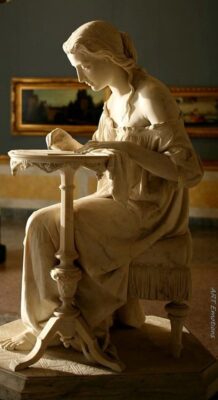
Conclusion
“Girl Writing” by Giovanni Spertini is more than just a sculpture; it is a celebration of human creativity, intellect, and artistic mastery. As a product of the Romantic era, it captures a timeless moment that continues to inspire and evoke admiration. Whether appreciated for its technical brilliance or its emotional depth, Girl Writing stands as a true masterpiece of marble artistry.

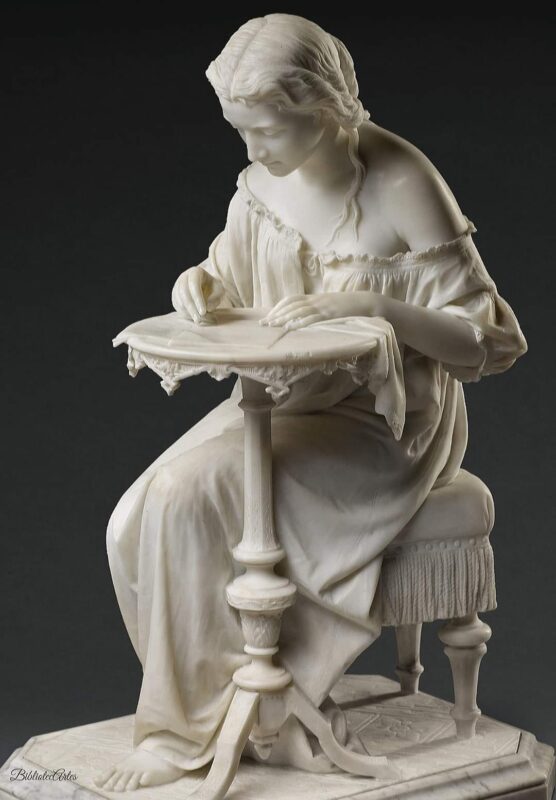
CÁC TIN KHÁC
Mary Walton: The Forgotten Inventor Who Helped Clean Up America’s Cities
Tomb of Queen Nefertari in the Valley of the Queens, Egypt
Discover the Hypostyle Hall of the Temple of Hathor at Dendera
Venus de Losange: Unveiling the Mystery of a 20,000-Year-Old Paleolithic Icon